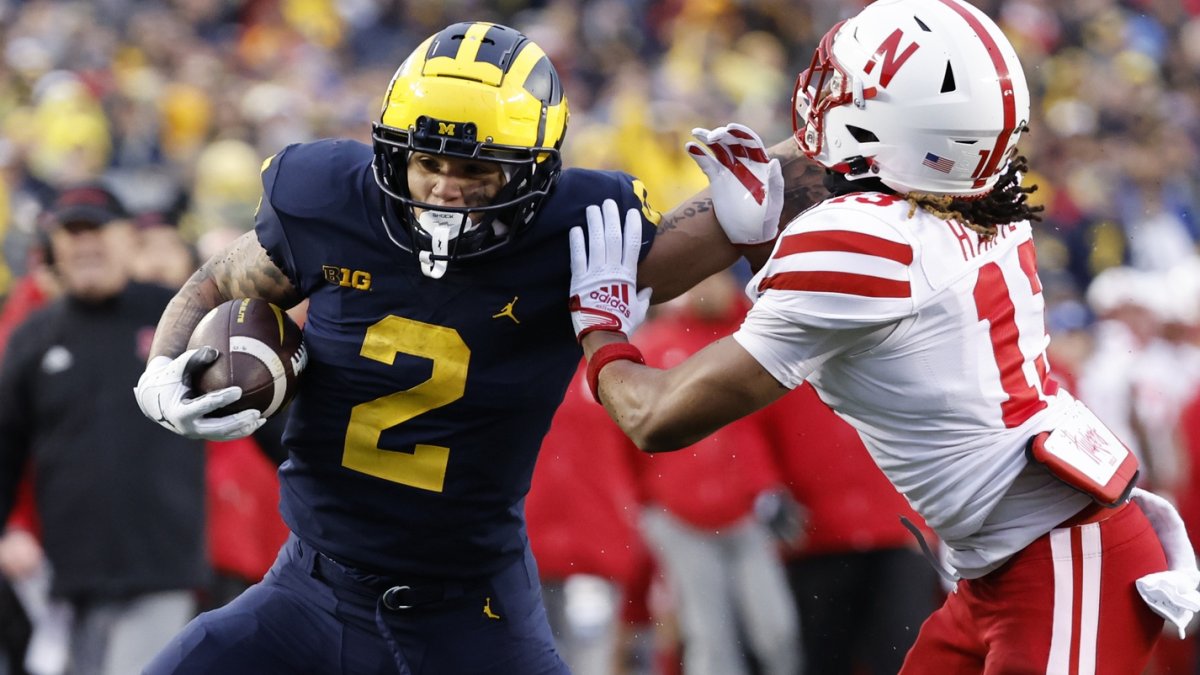“The most outstanding player in college football.”
That’s what the Heisman Trophy is supposed to be for. Yet, the nation’s most outstanding player wasn’t even one of the four finalists for the award. In fact, Michigan running back Blake Corum didn’t even win the Doak Walker Award, the annual prize presented to the nation’s best running back.
Corum’s 95.9 PFF grade led the nation this season. Not only that, but it was one of the best grades ever given to a player since we started grading college football in 2014.
Highest-graded seasons by a Power Five player in the PFF College era (Since 2014)
| Name | Position | School | Year | PFF Grade |
| Kyle Pitts | Tight end | Florida | 2020 | 96.0 |
| Chase Young | Edge defender | Ohio State | 2019 | 96.0 |
| Quinnen Williams | Interior defensive lineman | Alabama | 2018 | 96.0 |
| Blake Corum | Running back | Michigan | 2022 | 95.9 |
Pitts, Young and Williams were all eventual top-five draft picks. And while positional value will likely prevent Corum from joining that club, it still shows how well he's played this year, especially compared to this year’s Heisman finalists.
Comparing Blake Corum’s grade to Heisman finalists
| Name | Position | School | PFF Grade |
| Blake Corum | RB | Michigan | 95.9 |
| Caleb Williams | QB | USC | 90.9 |
| Stetson Bennett | QB | Georgia | 87.4 |
| Max Duggan | QB | TCU | 85.6 |
| C.J. Stroud | QB | Ohio State | 84.1 |
Speaking of positional value, that’s likely the biggest reason why Corum wasn’t even invited to New York City for the Heisman ceremony — the award has almost exclusively gone to quarterbacks and usually the quarterbacks of the country's best teams.
Heisman winners by position (Since 2000)
| Position | No. of winners |
| Quarterback | 19* |
| Running Back | 3 |
| Wide Receiver | 1 |
*Includes this season since all four finalists are quarterbacks
All four of this year’s finalists are quarterbacks, three of whom — Stetson Bennett, Max Duggan and C.J. Stroud — are playing in the College Football Playoff. However, none of those three ranks in the top 15 at the position in PFF grade.
For awards like NFL MVP, giving it to a quarterback makes sense; it’s by far the most impactful position in the league, and the trophy is quite literally for the “most valuable player.” In fact, the NFL’s most valuable non-quarterback, Tyreek Hill, is still behind 28 quarterbacks in PFF’s Wins above replacement (WAR) metric. The most valuable running back, Christian McCaffrey, ranks only 178th among all players.
That argument doesn’t hold true for the Heisman, even if the bias toward quarterbacks indicates otherwise. For starters, the Heisman Trophy is for “the most outstanding player,” not “the most valuable player.” And that's an important distinction since football is a sport where value fluctuates the most position by position.
But even if it was for the most valuable player, Corum still has a better case than nearly every player in the country.
While running back is one of the least valuable positions in the NFL, it’s actually one of the most valuable positions in college football. Running the ball is much more prevalent at the college level than in the pros, so running backs can make a greater impact.
The 5-foot-8, 209-pound junior has generated more value than all four Heisman finalists. He is not only the most valuable non-quarterback in the nation, but he’s also the fourth-most valuable player overall.
Comparing Blake Corum’s value to the Heisman finalists (per PFF’s WAA metric)
| Name | Position | School | WAA |
| Blake Corum | RB | Michigan | 1.20 |
| Caleb Williams | QB | USC | 0.90 |
| Stetson Bennett | QB | Georgia | 0.81 |
| C.J. Stroud | QB | Ohio State | 0.56 |
| Max Duggan | QB | TCU | 0.33 |
Therefore, the argument that the Heisman finalists made a larger impact than Corum because they are quarterbacks doesn’t hold much water.
The Heisman is ultimately a narrative-based award, which means it’s almost a necessity that the winner plays for a top team. It’s why the Power Five’s highest-graded quarterbacks — North Carolina’s Drake Maye and Alabama’s Bryce Young — didn’t have much of a chance. Neither of their teams made the College Football Playoff, while Maye’s Tar Heels are 9-4 and aren’t going to a New Year’s Six Bowl.
However, that argument can’t be applied to Corum. His Wolverines are heading to the playoff as the No. 2 team in the country and one of only two undefeated teams remaining in the nation.
Perhaps what’s hurting Corum the most is the ill-timed knee injury he suffered in Michigan’s penultimate regular-season game. That injury caused him to receive only one carry against then-No. 2 Ohio State in what was college football’s biggest game of the season and a golden opportunity for Corum to have his “Heisman moment.” He also missed the Big Ten championship game against Purdue and won’t be able to suit up for the College Football Playoff after undergoing season-ending knee surgery.
While Corum couldn’t play in Michigan’s biggest games of the season, that shouldn’t take away from what he’s done to get the Wolverines to this point.
Blake Corum is the highest-graded player in the country, one of the most valuable players in the country and plays on one of the best teams in the country.
And that’s the perfect recipe for a Heisman Trophy winner.




 © 2025 PFF - all rights reserved.
© 2025 PFF - all rights reserved.